
Volume 68 Issue 1 2023







2 ∙ Aquarium World TM Fresh New Look! Same Amazing Quality! C OL O R BOOSTING O m e g a O ne® i s p a c ke d w ith beta ca rotene , a natura l pi gm ent that will g i v e y o ur f i sh a br illi an t c olo r b o ost . E N E R G Y ENHANCING Wh ol e m ar i ne p rot ei ns , r i ch i n Om ega 3 & 6 fatty a c i ds , o ffer the h i gh e st qua li ty energ y s o u rc e f o r y o ur f i sh. S E R I O U S LY FRESH We ’ re n o t m ess i n g a ro und wi th m ea l s he re. Om ega O ne® i s ma de di rect ly f ro m w ho le , f re s h A l askan seafo o d . www.omegasea.net CHECK THE INGREDIENTS® The Best Fish Food in the World ®
ISSN
Aquarium World ∙ 3 EDITOR Darren Stevens editor@fnzas.org.nz ASSISTANT EDITOR Mark Paterson COPY EDITOR Caryl Simpson ARTISTIC DIRECTOR Diane Wilkie diane@scratchmedia.co.nz Aquarium World Magazine is published biannually by the Federation of New Zealand Aquatic Societies Incorporated (FNZAS)
2815-7435
©FNZAS, no part of this publication may be reproduced, or transmitted in
or by
electronic,
without written permission FRONT COVER Samurai Chocolate Gourami Sphaerichthys vaillanti Photo: Andrew Coffey www.fnzas.org.nz Volume 68 Issue 1 2023 5 EDITORIAL 7 CONTRIBUTORS 8 Samurai Chocolate Gourami by Andrew Coffey 16 TECHNICAL -Line breeding guppies by Aaron Gabb
FISH PROFILE - Betta coccina - scarlet or red wine betta by Maxine Lynch
A stunning local - Gobiomorphus huttoni
TECHNICAL - Propagating aquatic plants by Aaron Gabb
REPTILES & AMPHIBIANS - Brumation in reptiles by Mark Paterson 31 MINI FISH PROFILE - serpae tetra 32 PLANT PROFILE - Hygrophylla by Melanie Newfield 36 SHOP TOUR - KiwiPetz by Darren Stevens 40 INTERESTING IMPORTS by the Editorial Team 42 IMAGE SOURCES 43 FNZAS AFFILIATED CLUBS 44 FNZAS SHOP DISCOUNT PARTICIPANTS
Copyright
any form,
means
mechanical or otherwise
18
22
24
28

Welcome to a new issue of Aquarium World.
In New Zealand we are nearing the end of winter. For reptile keepers, their pets might be brumating. Seeing your pet slow down and stop eating can be quite scary and in this issue, Mark Paterson provides some great advice on how to look after a brumating reptile.
On the fish front we profile two blackwater beauties: the samurai gourami, a supposedly timid species which provides its share of challenges, and the scarlet betta, a stunning alternative to the popular betta. Both these species are rarely seen in New Zealand, and it is great to see the importers bringing in some more unusual species.
For tropical plant fans, Melanie Newfield continues her great aquatic plant series, this time on the popular Hygrophila species, and Aaron looks at how to propagate aquarium plants.

And finally, we profile KiwiPetz in Tauranga. A spacious well stocked store that is well worth a visit.
Darren Stevens FNZAS Editor


EDITORIAL
Betta coccina
Photo: Maxine Lynch
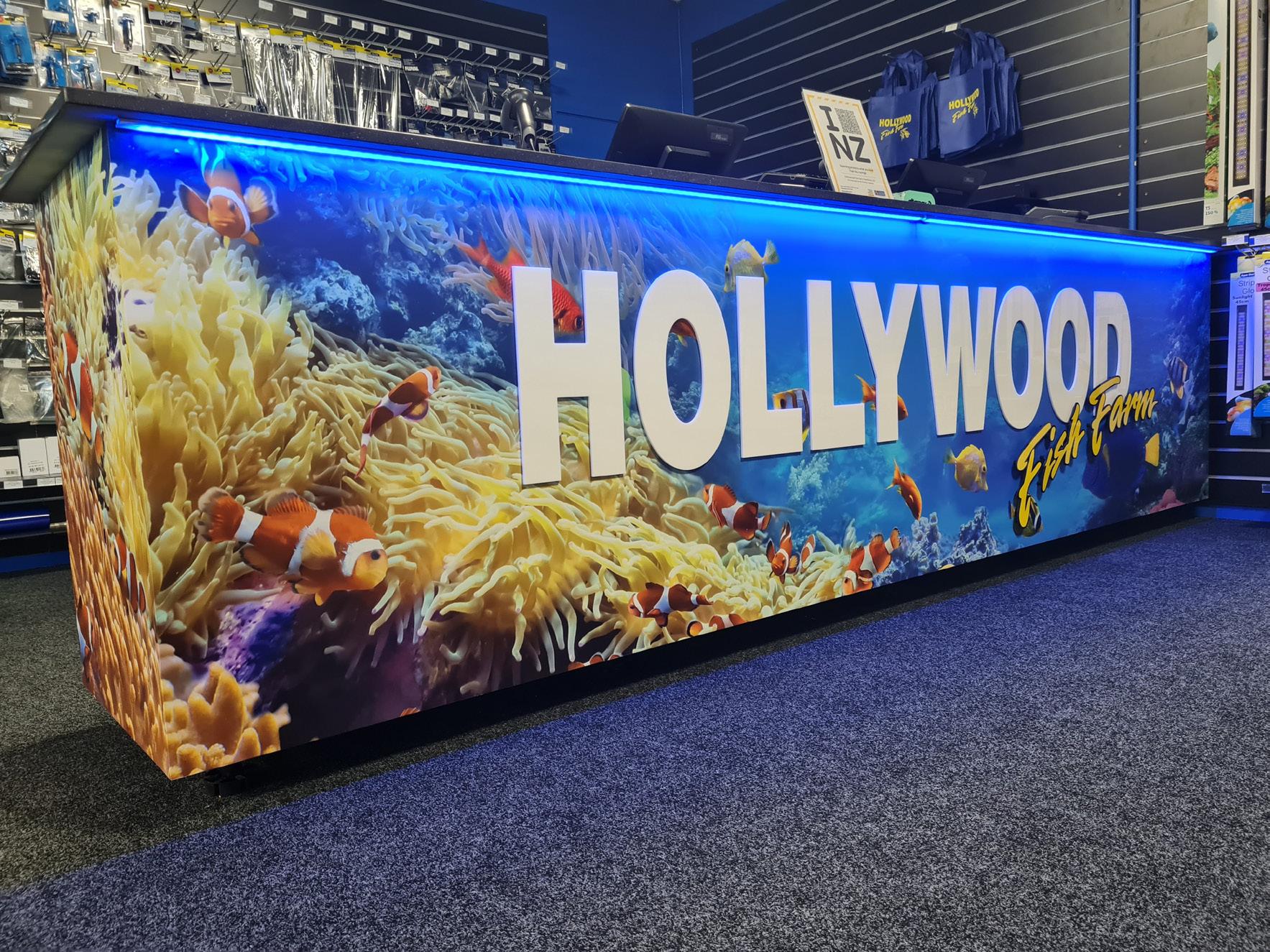
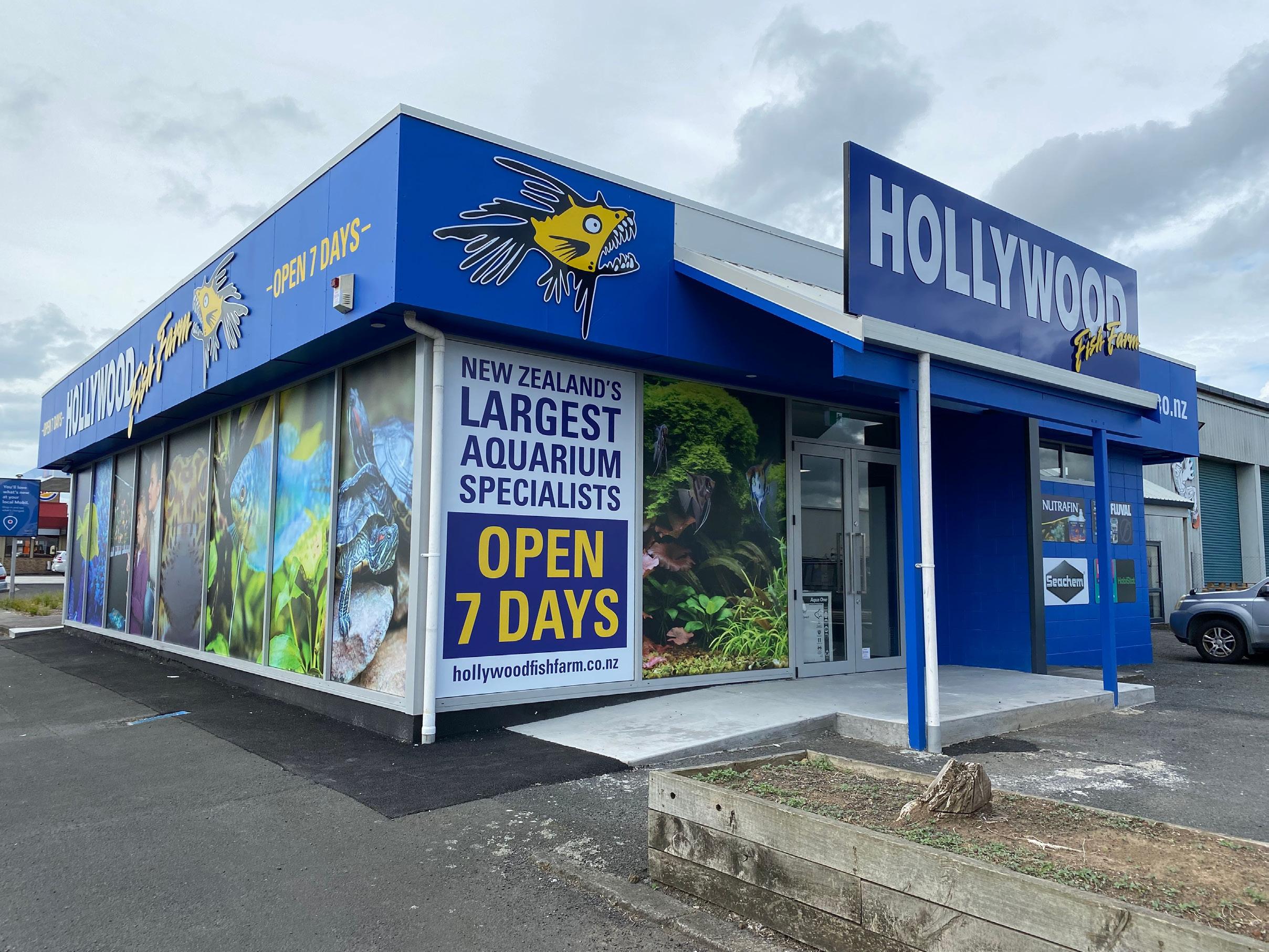


HAMILTON HAMILTON HAMILTON NOW OPEN NOW OPEN OPEN 7 DAYS 9:30AM - 5:30PM
Andrew Coffey

Andrew can’t remember a time as a child that he wasn’t keeping tadpoles, frogs and fish from local ponds There have been times in his life that he has been in remission but he freely accepts that he has been afflicted by ‘MTS’ for the best part of 30 years. In the past he has kept and bred a variety of Plecos, African cichlids, and rainbow fish. Currently he is keeping and breeding Tanganyikan cichlids, Victorian haps and is trying his luck with apistogrammas and various oddballs.
Maxine has been a fish keeper for most of her life, with a passion to continue killifish strains in New Zealand, to ensure that as many varieties of this beautiful species are available to future fish keepers. With a passion for nano fish, most of her fish-garage is made up of tanks of less than 200L, with the exception of a 1000L tank that was put in for rescues. Maxine is a public servant and has held various roles in her time in the FNZAS.
Aaron is a second generation fishkeeper/breeder, there hasn’t been a time in his life where he didn’t have a fish tank of some description. Breeding fish for so long has led Aaron down the rabbit hole that is linebreeding & learning about genetics. Currently he is linebreeding a few strains of fancy guppies and Siamese fighters. Another ‘addiction' is killifish, pound for pound the most colourful fish in our hobby in his opinion. Aaron enjoys seeing people breed their fish & establish strong genetics within New Zealand. He loves the challenge in breeding rare or unusual fish.
Mark began fish keeping when he was a child, keeping live bearers and Siamese fighters. He has worked for circus and zoo parks in NZ and overseas. For the last 28 years he has kept many species of aquatic life but NZ local marine is his keenest interest. Mark loves to share this passion & knowledge with fellow hobbyists and is currently running the marine systems at a local university.
Darren is a marine biologist who has worked for NIWA for about 20 years. He regularly participates in research surveys and has been around much of New Zealand as well as Oman, UAE, and the Ross Sea, Antarctica. In his spare time he enjoys fishing, and is a particularly passionate pleco keeper. Darren is an active participant in his local clubs and FNZAS Editor.

Melanie returned to fish keeping last year after a 25 year break. She originally studied botany and is as keen on plants as well as fish. Her tanks are mainly planted, aquascaped community tanks. She also has a lifelong interest in invasive species, especially invasive plants.

Accounts: Patricia Lynch treasurer@fnzas.org.nz
Caryl Simpson caryl@simtronics.co.nz


Aquarium World ∙ 7
Advertising for the Aquarium World magazine and the Aquarium World website is managed by the FNZAS and can be arranged by emailing: advertising@fnzas.org.nz
CONTRIBUTORS
Darren Stevens
Melanie Newfield
A species profile and cautionary tale of falling in love at the LFS

8 ∙ Aquarium World
Samurai Chocolate Gourami
by Andrew Coffey

World ∙ 9
Aquarium
Sphaerichthys vaillanti goes by a few common aquarium names such as Vaillant’s chocolate gourami and the rainbow chocolate gourami but is probably best known in New Zealand as the samurai gourami. It is a small, interesting anabantoid that is rarely available in NZ shops. The female samurai also has some of the most striking patterning you will see on any fish. It has definitely been a fish that has been on my ‘to do’ list for many years. I had kept Sphaerichthys osphromenoides - the more commonly available chocolate gourami many


10 ∙ Aquarium World
Female Sphaerichthys vaillanti samurai gourami
Photo: Andrew Coffey
Sphaerichthys osphromenoides chocolate gourami
Photo: Tsunamicarlos
years ago. But at that time, I had far less fish keeping knowledge so my success in keeping them was limited. So, on a random afternoon in early June (2023), I walked into my local fish store to get some food supplies and saw a group of samurai gourami in a tank. They looked as amazing as I had always imagined them to be, it was love at first sight, and I was soon walking out of the shop with 3 pairs of these small delicate fish.
The genus Sphaerichthys comprises 4 species, all known commonly as ‘chocolate gourami’. The samurai is
the only one to have the amazing striped red and green colouration in the female. The male is a camouflage pattern of browns and neutral tones, and similar to the males and females of the other 3 species. The samurai is one of the two species in the group to be a paternal mouth brooder (male broods the eggs).
Samurai gouramis are found in slow running waterways and peat swamps in the lowlands of the southwest

Aquarium World ∙ 11
Sphaerichthys vaillanti
Photo: Andrew Coffey
corner of Indonesian Borneo. These waters are fed by the huge rainfalls that occur in the mountainous centre of the island, flooding in the wet seasons but drying out to leave a mosaic of black water streams. Cluttered with organic matter, the water is extremely soft and can be highly acidic. The pH drops to as low as 3 - 4, although forested areas have clearer water with pH in the 5’s. The samurai lives in these small water systems, its colour and shape disguising it as a dead leaf and easily hiding it amongst the network of organic clutter. This region of
Borneo, like so many areas of tropical rainforest around the world, has experienced massive intensification of human development causing many of the samurai gourami’s natural habitats to be under imminent threat, or already lost. The fish is on the International Union for the Conservation of Nature (IUCN) red list of threatened species as ‘Vulnerable’.
Samurai gouramis only get to about 5.5cm and show little sexual dimorphism when young, the females not developing their vertical barring
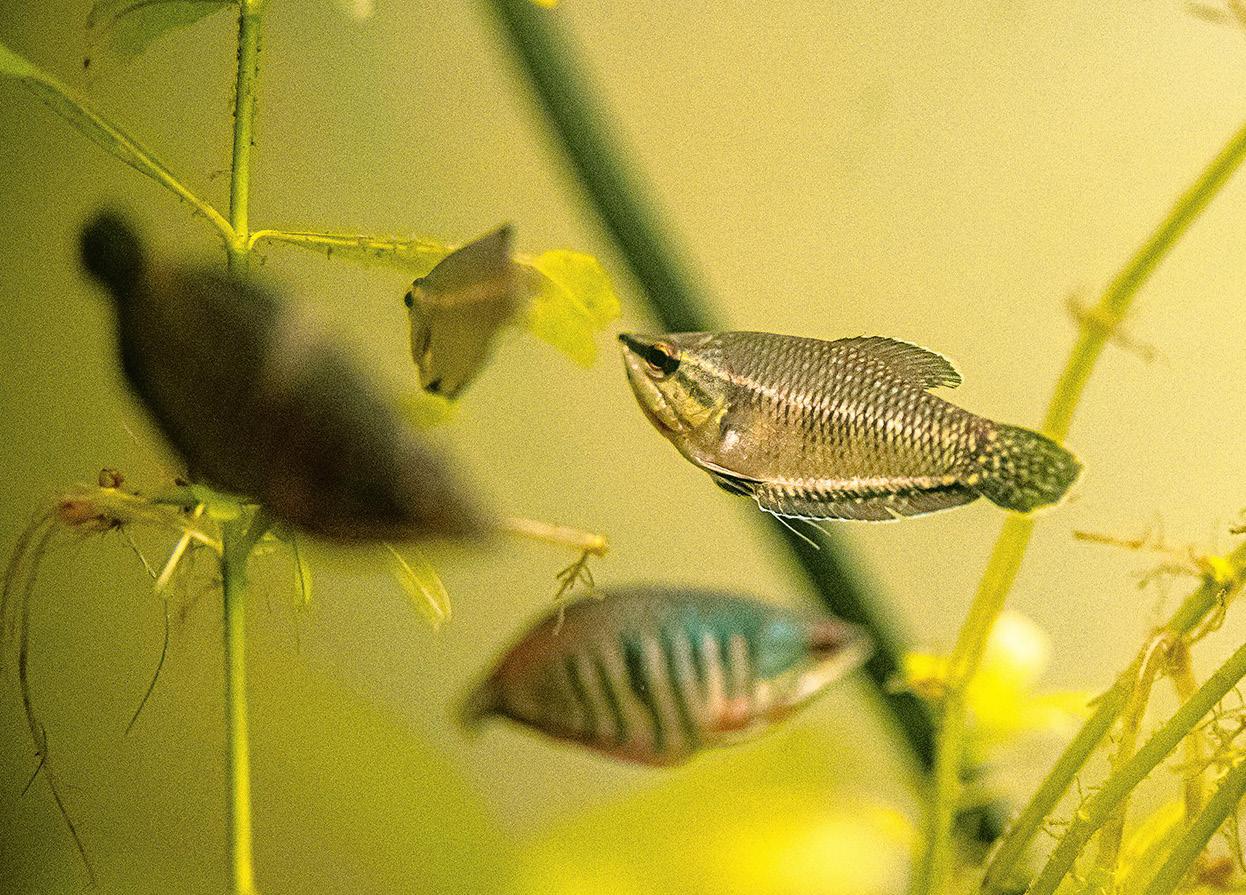
12 ∙ Aquarium World
Male Sphaerichthys vaillanti showing rounded bottom jaw Photo: Andrew Coffey
until older. The males also have a more rounded lower jaw compared to the straight lower jaw of the female which becomes more noticeable with age. This is due to the presence of an expandable skin cavity in their throat that is used during mouth brooding. The 3 pairs I bought were about 3.5cm so sexing them was possible although not guaranteed.
I initially moved my 6 young samurai into a 3-foot 120 litre tank. It was a growout/utility tank that already had many of the requirements needed as it had been used for Apistos. The only other inhabitants were a small school of rather shy green neon tetras and the samurais seemed to acclimatise to the new home well.
Lower pH levels are required as are lower TDS levels. It can be very difficult to achieve a pH of 4 and keep it consistent so I was happy achieving mid 6’s and this is low enough to get the fish spawning. I’m on rainwater tanks at home so with the addition of dried leaves, peat moss and other botanicals, it is fairly easy to reach this pH level and TDS of around 30ppm. Sand substrate is ideal and well oxygenated water with little to no flow is preferred. So, sponge filters with air stones were a good choice. I also set up a 2-foot 70 litre tank with the same parameters as a fry raising tank.
As per all the literature I read, they are peaceful, shy, slow-moving fish that could easily be outcompeted for food. However, their conspecific behaviour was interesting to watch
from the time they were released into their new home. There was definitely some social jostling but nothing too problematical at that stage.
It is recommended to get a group of young and grow them out looking to create mated pairs, so when I lost the most subordinate male after only 3 days, I was disappointed but philosophical. These things are to be expected if you’re looking to breed fish. It wasn’t long before the other fish paired off, with an obvious alpha pair, then second pair and a lone female who, unfortunately, went the way of the subordinate male. So within just over a week, my 6 fish were 4.
Samurais are naturally a micro predator, so I found them happy to swim amongst clouds of micro and vinegar worms. They also readily accepted small white worms and good frozen foods like bloodworms and brine shrimp.
The tank was set to 26°C and, while they seemed to move through all parts of the water column, they spent large amounts of time sitting motionless in the top part of the tank with the floating plants supplying cover as well as keeping the lighting dim, which they appreciate.
The two pairs separated into two halves of the tank and kept to themselves, only meeting at feeding times, and levels of aggression were more shows of dominance rather than any real attacks. Subdominant fish would turn on their side and lay flat as if dead when confronted by the
Aquarium World ∙ 13
alpha pair. Sooner than expected, I was seeing spawning behaviour when the alpha pair would swim to the tank bottom and circle each other in an elaborate dance that seemed to last hours and the male soon was showing a bulge in his throat cavity. Males will brood the eggs/ fry in their mouths for 14 - 23 days before releasing fully formed, free swimming, young. At about 15 days I transferred the holding male into the 70 litre tank that had the exact
microworms is all I added. Upon reintroducing the male, the proverbial hit the fan.
The reunited pair killed off the subdominant pair within 3 - 4 days and were even showing aggression to each other. They seemed to take turns at being the dominant partner and harassing each other.
At the time of writing this account (early August) I had removed the pair to the small tank and while this means I only get to see them rarely in the dark stained water, it at least keeps them peaceful and happy. They will hide for days in the leaves and woodwork, only occasionally swimming openly in the tank. I’m uncertain if there are any fry in the tank.
conditions of the bigger tank (I had used media and leaf litter from the larger tank). I also added a mesh bag of peat moss to soften things a little more.
After about a week of checking daily, I noticed the male was no longer holding so I removed him back to the group tank. While I think I saw the little movement of possible fry, the tank is so dark and covered it was hard to be sure. The tank has a lot of broken-down leaf litter so lots of microorganisms for fry to fed on, so the small addition of some
So, my conclusion so far is that while these are a gorgeous and fascinating little fish, they are definitely not for an inexperienced fish keeper. Their very specific care requirements, and rather inconsistent and complex conspecific behaviour,

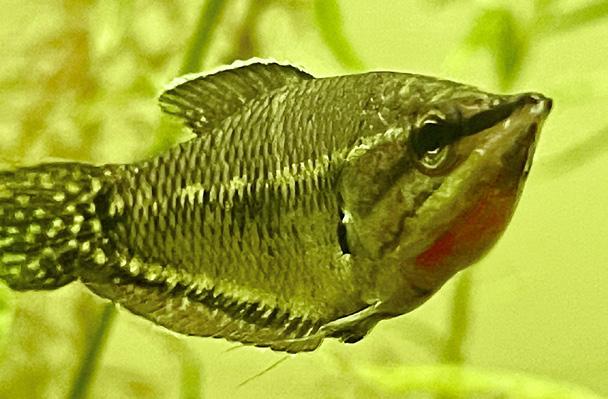
14 ∙ Aquarium World
Male Sphaerichthys vaillanti holding eggs
Photo: Andrew Coffey
probably indicates why these fish are not common in the hobby and not commonly tank bred. I will leave my remaining pair alone and see what happens. I think if I was to try with a chocolate gourami again, it will be with one of the other species as while they still require quite specific parameters to tank breed successfully, they don’t appear to have quite the same level of conspecific aggression as the so called ‘peaceful samurai’.

Anderw Coffey

Aquarium World ∙ 15
above: 70 litre blackwater tank set up for fry raising and now home to surviving pair
Photo: Andrew Coffey
Line Breeding Guppies
Line breeding is a selective breeding method used to develop and improve a particular strain of a species. This method involves breeding individuals that have similar characteristics to reinforce those traits in future generations. In the case of guppy strains, line breeding is a popular method used by breeders to create distinct, genetically stable strains.
Guppies are one of the most popular species of freshwater fish kept in home aquariums. They are known for their bright colours, lively personalities, and ease of care. Guppies come in a wide range of colours and patterns, and this variety has led to the development of many different strains.

To create a line-bred guppy strain, a breeder will start with a group of guppies that share a specific trait, such as a particular colour
or tail shape. These individuals are then selectively bred with each other to reinforce the desired trait. Over time, the offspring of these pairings will start to exhibit the desired trait more consistently, and the breeder can continue to selectively breed these individuals to develop a stable strain. One of the key benefits of line breeding is that it allows breeders to create guppy strains that are genetically stable. This means that the offspring of the strain will exhibit the same characteristics as their parents, making it easier for breeders to predict the traits of future generations. This predictability is important for breeders who want to create and maintain a specific strain.
16 ∙ Aquarium World TECHNICAL
Aaron Gabb
Poecilia reticulata - Green tail guppy
Photo: Robert Beke
However, there are also potential drawbacks to line breeding. One of the biggest concerns is the risk of inbreeding. When individuals with similar genetic backgrounds are repeatedly bred together, there is a higher risk of passing on harmful recessive genes. This can result in reduced fertility, increased susceptibility to disease, and decreased overall fitness.
To mitigate the risk of inbreeding, guppy breeders must carefully select individuals for breeding and avoid mating closely related fish. They may also periodically introduce new genetic material from outside sources to refresh the gene pool and maintain genetic diversity.
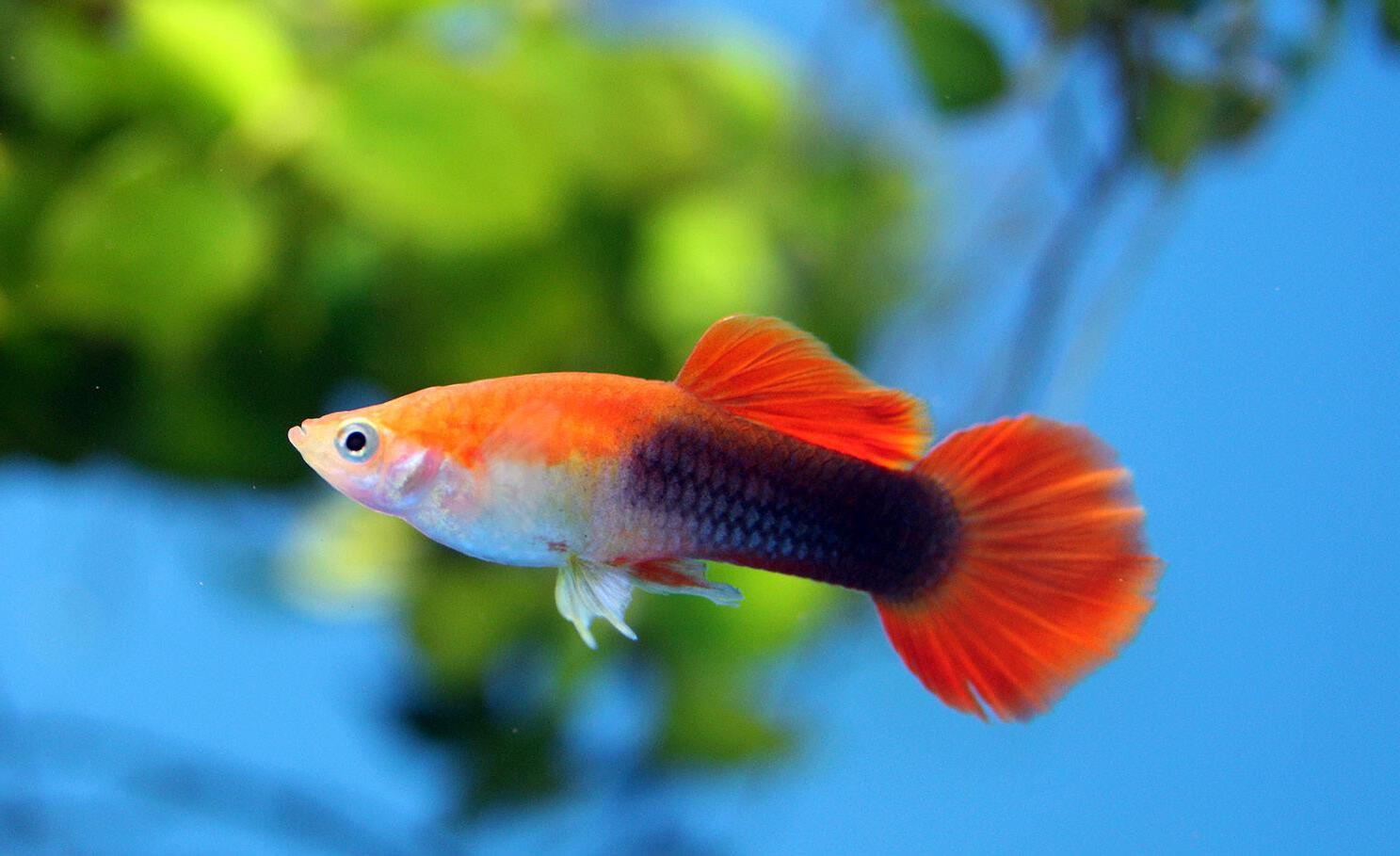
The goal of line breeding is to produce offspring that are homozygous for the desirable traits. Homozygous individuals
have two copies of the same gene, which increases the likelihood of passing on the desired trait to their offspring. This is in contrast to heterozygous individuals, which have two different copies of the same gene and are less likely to pass on the desirable trait.
When line breeding guppies, it is essential to keep accurate records of the breeding process. This includes keeping track of the lineage of each individual, as well as their physical characteristics and breeding outcomes. This information is crucial in selecting the best individuals for breeding and ensuring that the breeding population maintains genetic diversity
Aaron Gabb
Aquarium World ∙ 17
Poecilia reticulata - Red tuxedo guppy
Photo: Robert Beke
When these guys got imported into NZ this year, and they were no exception!

FISH PROFILE 18 ∙ Aquarium World
Scarlet or Red Wine Betta Betta coccina

year, I HAD to get some. We all know I LOVE bettas,
Profile and photos by Maxine Lynch
Betta coccina is a small red betta found in Jambi (Sumatra), Johor and formerly in Malakka (Malaysia). It was first described by Jörg Vierke in 1979 who gave the small betta the name coccina, which means wine-red or claret, a description that perfectly suits the fish if you look at its colour. The only difference between the species from Malaysia and B coccina from Sumatra are little colour differences which are common for most type localities.
B coccina naturally come from peaty swamps, so we want to try and reflect this in our tank conditions, so we use peat, Indian almond leaves, and black water extract. Their natural habitat is shady so they like the temperature a bit lower (24 to 27 °C). They love to have plants in the tank to swim among or just “hang out” in.
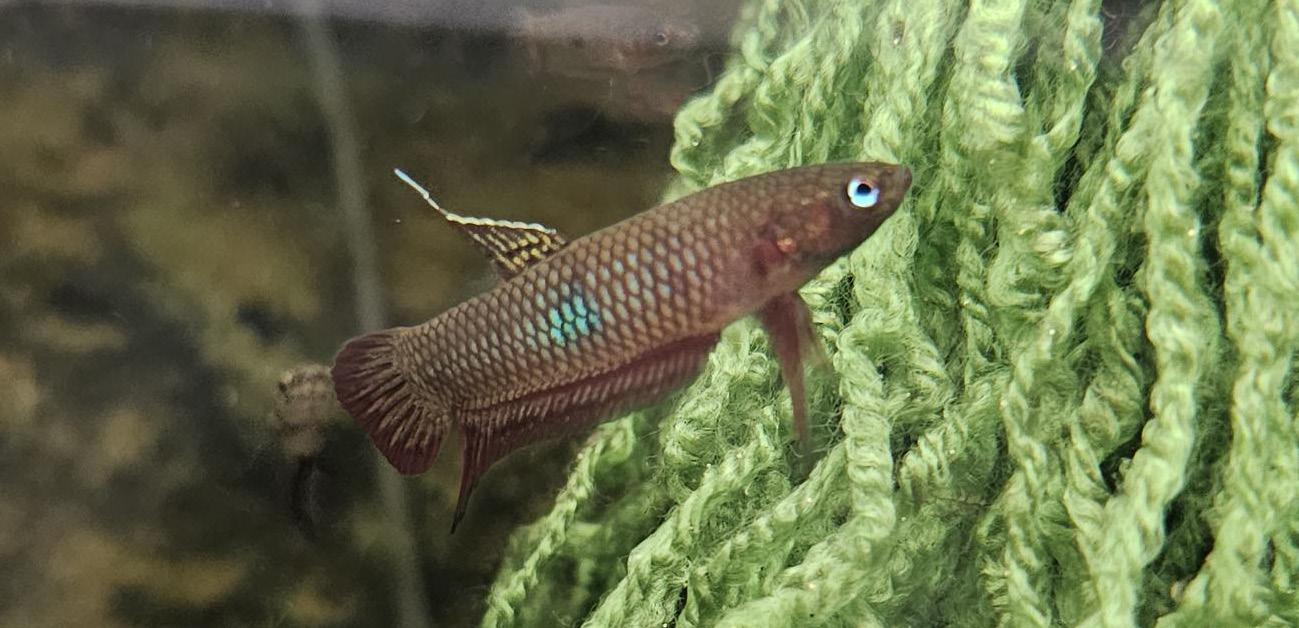
They are egg layers who put their spawn in a bubble nest. The really unique thing about these guys is they prefer to build their nest in a top water cave or hollow. Females tend to be a bit duller in colour and have shorter finnage. Young males will have a bright green spot on the side of them, that slowly disappears. They have the most mesmerizing eyes – a bright green eye which is a pop of colour in any dark water tank, truly phenomenal. They aren’t in the peaceful category, but you can maintain this species in a group, and they don’t necessarily predate on fry.
I can’t say we did much to get ours to breed other than to provide some caves at the top line of the water. They did the rest. We feed our B coccina a mix of live food and other pre prepared betta foods which they readily eat.
20 ∙ Aquarium World
Lynch
Maxine

For all your aquatic needs under one roof We can provide both expert advice and a wide range of supplies to help you look after your fish and reptiles 10 % discount Off items not already discounted Applies to current FNZAS members Membership card must be shown OPEN 7 DAYS Mt Roskill Branch 36 Frost road Mt Roskill 10am till 6pm 09 962 5249 Albany Branch Albany Trade Centre 10/2 Tawa Drive 09 415 4157 SHOP ONLINE www.hollywoodfishfarm.co.nz
A Stunning local
With their striking red fins and tail, male redfin bullies ( freshwater fish. Females are similar but have brown markings. stony streams near the coast, eat mainly insect larvae,
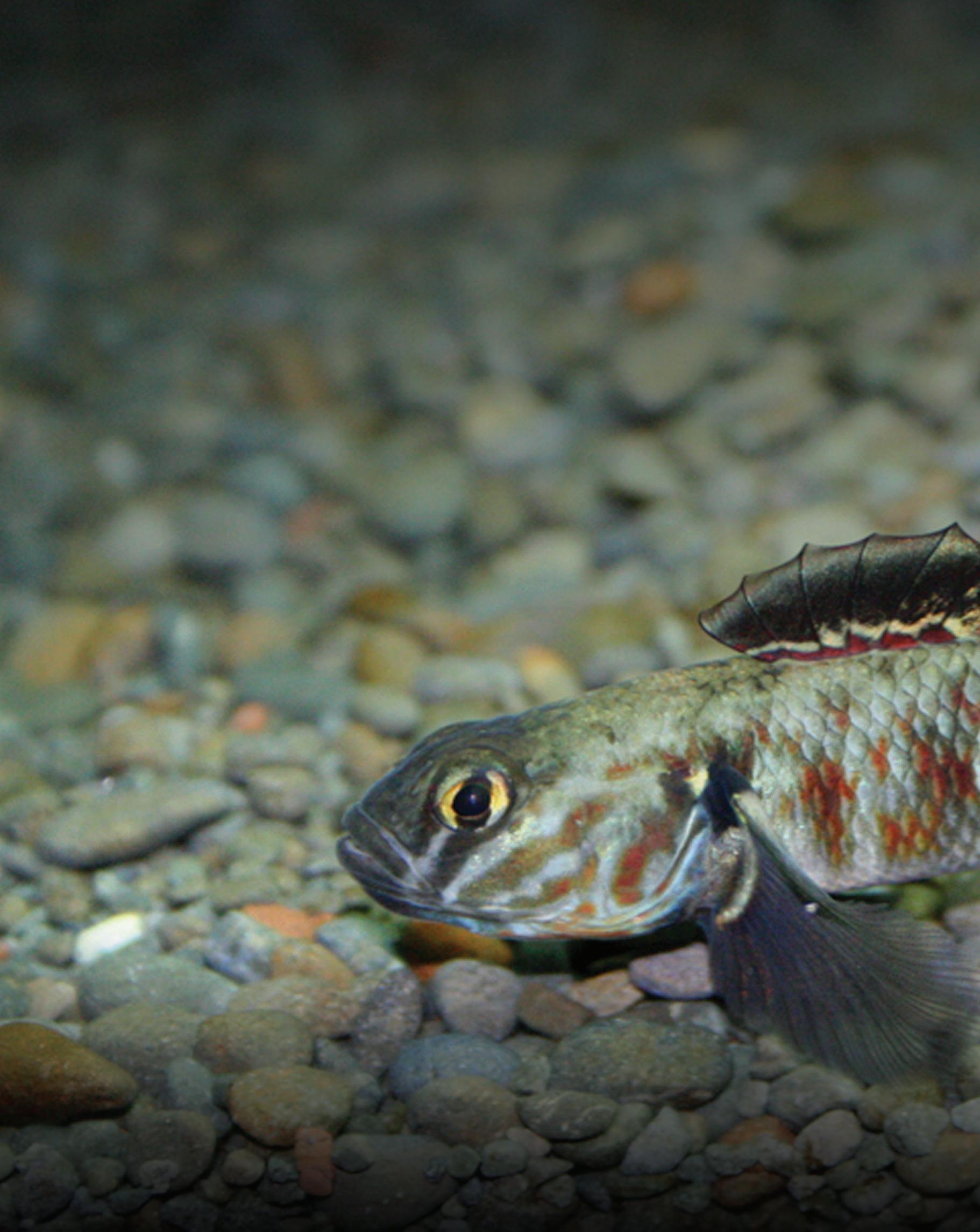
22 ∙ Aquarium World
(Gobiomorphus huttoni ) are our most attractive markings. Redfin bullies are usually found in small larvae, and grow to about 8-10 cm.
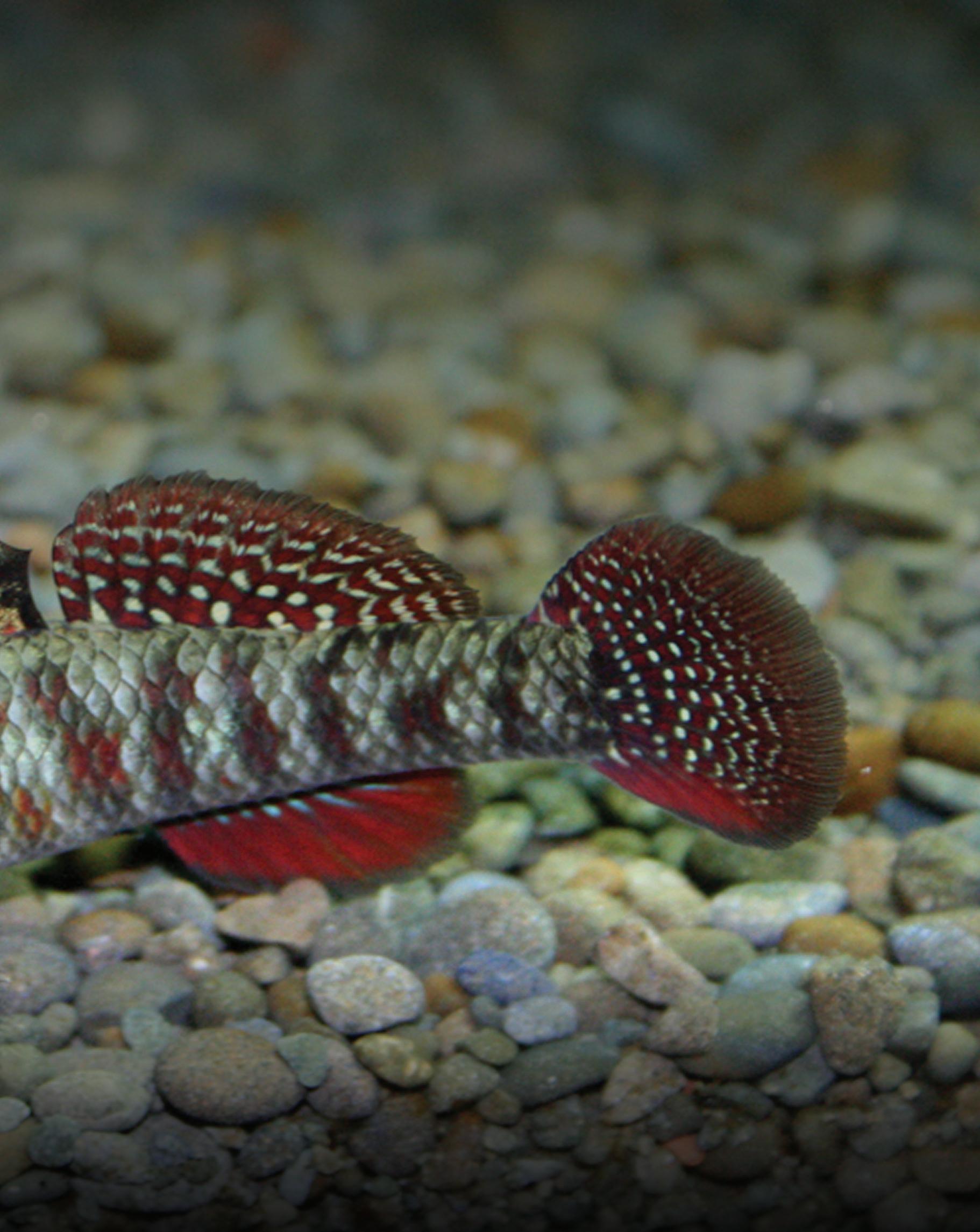 Photo David Cooper
Photo David Cooper
TECHNICAL
Propagating aquatic plants
Aquatic plants play a vital role in creating a healthy and beautiful aquarium. They not only provide a natural habitat for aquatic animals but also help to maintain the overall balance of the aquarium ecosystem. Propagating aquatic plants can be a cost-effective way of increasing the number of plants in your aquarium and can be a fun and rewarding experience.
In this article, we will discuss the process of propagating aquatic plants for the aquarium.
Choose the Right Plants
The first step in propagating aquatic plants is to choose the right plants for your aquarium.
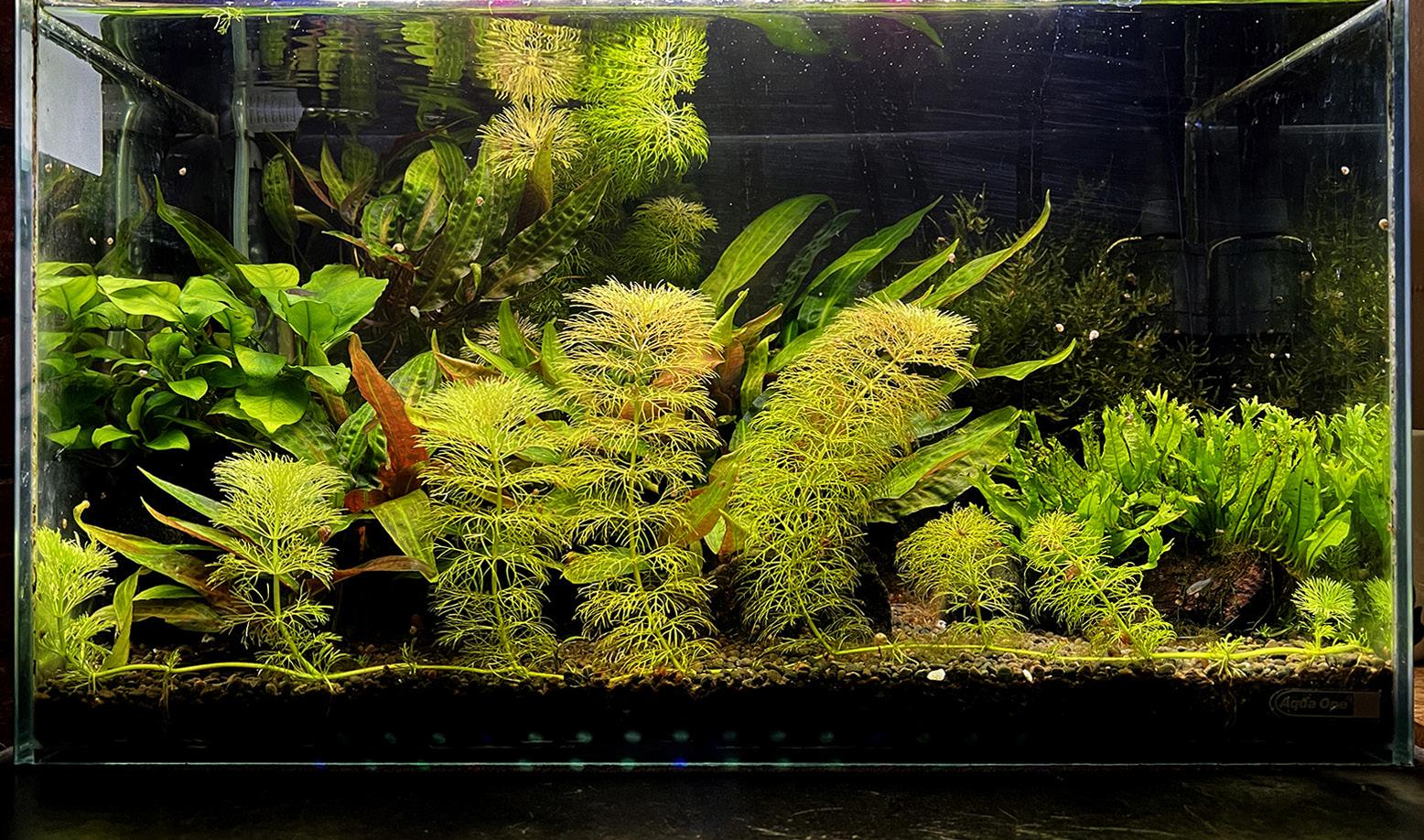 by Aaron Gabb
by Aaron Gabb
Some plants are easier to propagate than others, and some plants may not be suitable for your aquarium environment. Choose plants that are known to propagate easily, such as Java fern, Anubias, and Amazon sword.
Understand the Plant's Reproduction Method
Different aquatic plants have different methods of reproduction. Some plants propagate through runners or stolons, while others produce offsets or plantlets. Knowing the reproduction method of your plant will help you
24 ∙ Aquarium World
Ambulia plantlets on stolon
Photo: Diane Wilkie
understand how to propagate it successfully.
Preparing for Propagation
Before you start propagating aquatic plants, it's essential to prepare the necessary equipment. You'll need a pair of scissors or pruning shears to cut the plant, a container of water to hold the cuttings, and a substrate to plant the cuttings. You may also want to use fertilizer to encourage growth.
Propagating Through Runners or Stolons
Plants that propagate through runners or stolons, such as the Java fern, produce small plantlets along the length of the runner. To propagate these plants, simply cut the runner close to the plantlet and plant it in the substrate. Make
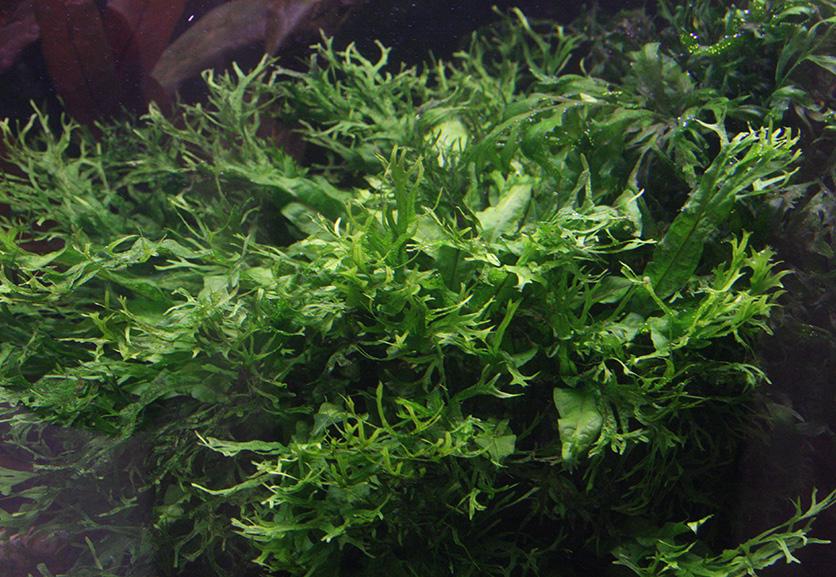


sure the plantlet has access to light and nutrients, and it will grow into a new plant.
Propagating Through Offsets or Plantlets
Plants that produce offsets or plantlets, such as the Amazon sword, will grow small plants from the main plant's base. To propagate these plants, gently remove the plantlet from the
Aquarium World ∙ 25
Philipine java fern
Photo: Jennifer Hamlin
Windelov java fern
Photo: Jennifer Hamlin
Echinodorus adventitious plantlet on flower stem
Photo: Jennifer Hamlin
parent plant using scissors or pruning shears. Plant the plantlet in the substrate, making sure it has access to light and nutrients.
Caring for Propagated Plants
After propagating your aquatic plants, it's essential to care for them properly. Ensure the newly propagated plants have access to light, nutrients, and carbon dioxide. You may want to use a liquid fertilizer to encourage growth. Keep an eye on the plants and remove any dead or dying leaves.
Propagating aquatic plants for the aquarium can be a rewarding and cost-effective way of increasing the number of plants in your aquarium. By choosing the right plants, understanding the plant's reproduction method, and caring for propagated plants, you can successfully propagate aquatic plants and create a healthy and beautiful aquarium environment.
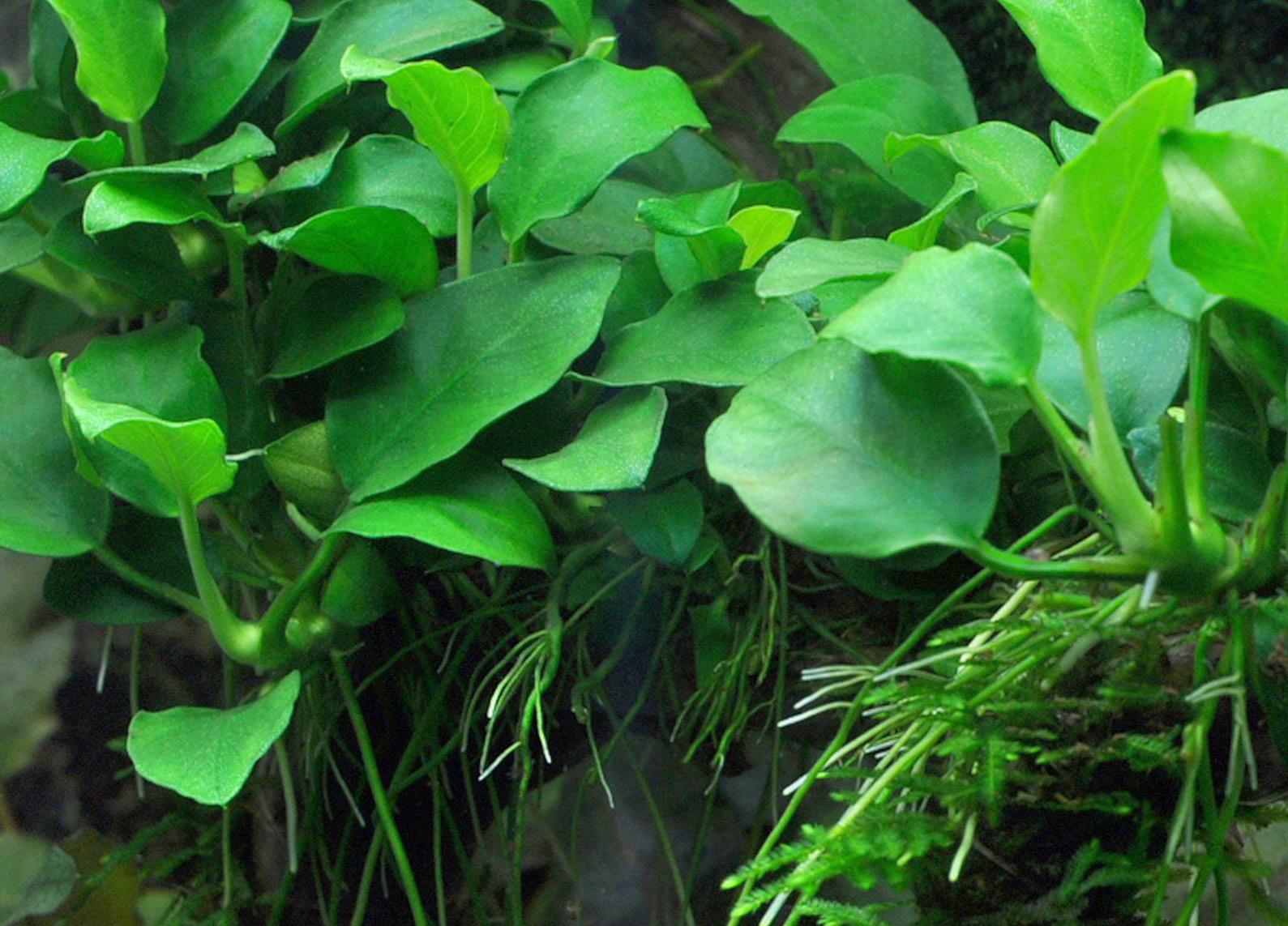 Aaron Gabb
Aaron Gabb
26 ∙ Aquarium World
Anubias
Photo: Elizabeth Gutierrez Toledo
innovative, patented 3D fiber structure
removes even particles above 10 µm such as floating algae or sludge
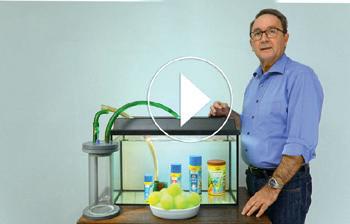
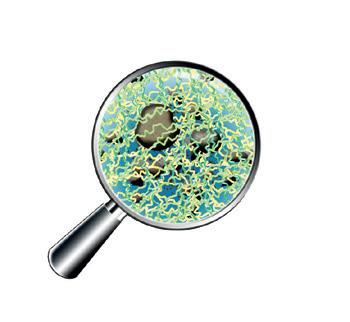







keeps its shape permanently and can be washed out
7 product test

Aquarium World ∙ 27 24 h Start
High performance filter medium for mechanical filtration
1 h
NEW
Available from: www.scalesandtails.co.nz We Lo v e Fish 7 crystal clear
Brumation in Reptiles
 by Mark Paterson
by Mark Paterson
For new reptile keepers, often the greatest source of worry is when your reptile becomes lethargic, inactive and doesn’t want to eat. Your animal seems to be in good health, the temperatures are right and UVB lighting is good, but your reptile has stopped eating and sleeps the days away, it may be going into brumation. Brumation is a state of dormancy in reptiles and some amphibians, the coldblooded equivalent to hibernation in mammals, and is a response
to changing seasons and cooling temperatures.
Don’t panic, as this instinctual behaviour may be what is happening to your dragon, skink, gecko or amphibian. Exotic reptiles in New Zealand seem to begin brumating around March/April and some animals may sleep right through to August or September. How and where they brumate
28 ∙ Aquarium World
Bearded dragons
Photo: Mark Paterson
REPTILES & AMPHIBIANS
can vary for different individual reptiles but you generally find most reptiles retreat to their hide, or bury themselves under the substrate, while some amphibians brumate under water. Let your animal decide what it wants and needs. Youngsters often do not brumate in their first year but adults usually do. Some youngsters under 12 months old and in good condition may brumate but it is usually recommended to avoid this.
During brumation, their metabolism slows right down and while some may wake have a drink and go back to sleep again, others will sleep right through. Don’t try to force water or food on the reptile during this period and try to minimise disturbing it, though a quick check to ensure it is alright is okay. Even though your captive reptile has constant warm

Aquarium World ∙ 29
Blue tongue skink Photo: Mark Paterson
temperatures, brumation can sometimes occur at any time of the year, and it is very stressful on the reptile. Before brumation it is good to ensure your reptile is in good health, with a vet check including a faecal test to ensure they aren’t full of parasites. This will set your mind at rest and help ensure a good outcome for their awakening.
In captivity, environmental conditions can be manipulated by the keeper at any time by reducing lighting hours and temperature. However, it is best to let your reptile decide when it is time to brumate as forcing it into brumation can create issues. The reason I recommend letting your

animal brumate naturally is so it can go through the normal process of slowing down and stopping eating while temperatures are still warm as this allows any food to be digested, and the stomach and bowels to empty, preventing any retained food or waste from rotting during their long sleep. Some scientists also feel that brumation allows their bodies to clear toxins and helps trigger the production of sperm in males and helps prepare females for ovulation in spring, allowing for bigger and more viable egg clutches.
The length of time a reptile
30 ∙ Aquarium World
Australian water dragon
Photo: Mark Paterson
brumates is extremely variable, anything from 3 or 4 weeks to 3 or more months. Desert species tend to brumate much longer than forest species and some tropical animals don’t brumate but just slow down their activity and feeding patterns. Most reptiles generally do not feed during brumation but they may wake to hydrate themselves, so ensure their water dish is always full of clean water. I wait about 3 - 7 days after the animal goes to sleep before turning the heating off to ensure any food left in the stomach will be digested properly. I then turn the heating back on
when the animal wakes properly. Once they wake up, they may take several days to get back to their normal behaviour. Just ensure the lighting and heating is correct to create a safe transition back to normality. They may take a little longer to eat but ensure food is there to eat when they are ready. A healthy bearded dragon, with no internal parasites, should come out of brumation not weighing much less than when it started and will usually get back into a routine fairly quickly, allowing you to get back to enjoying your pet.
Mark Paterson
serpae tetra
The serpae tetra (Hyphessobrycon eques) is a small (to about 4 cm) colourful tetra that has been in the hobby for many years. In the wild they are found in slow moving waterways throughout much of the Amazon River drainage. Serpae tetras should be kept in large schools (at least 12 fish) in good sized tanks. This allows for more natural behaviour and reduces the chances of fin nippving. Gold and long finned varieties are also available in New Zealand. They should be offered a varied diet and are well suited to temperatures of 22–27°C.

Aquarium World ∙ 31
Photos Robert Beke & Faucon
FISH MINI PROFILE
Hygrophila
by Melanie Newfield
If you keep your plants neatly trimmed, then you’re unlikely to see many flowers in your tank, since most aquatic plants flower on the surface of the water or held above the water surface. However, I’m a bit lazy when it comes to pruning and I’ve got a couple of tanks growing near windows, so I often have plants sprouting out of the top. Sometimes, my laziness is rewarded with flowers.
Right now, I’ve got a lovely shoot of Hygrophila corymbosa sprouting out of my largest tank. The flowers are pale purple, and on close inspection they’re marked with white blotches. As well as the flowers, which are never seen underwater, the above-water stems differs from the underwater stems in other ways as well. The leaves are shorter and wider, the stems are hairy and if you brush against the plant, it has a distinctive, herbal smell. As far as I can tell, the underwater stem doesn’t smell of anything but fish tank.
Having very different underwater and abovewater stems is a common feature of aquatic plants. Botanists call the underwater parts ‘submersed’ and above-water stems ‘emersed’. Plants with different leaf forms are called heteromorphic or heterophyllic.
Depending on which botanist you ask, there are somewhere between 25 and 100 species of Hygrophila. The taxonomy is confused, with different names used in the aquarium trade and among botanists. As a result, I’m not sure exactly how many species are commonly in cultivation in New Zealand, but there seem to be four. There are a number of other names in use, which are synonyms or refer to different forms.
Hygrophila corymbosa
As aquarium plants go, this is a robust plant. It has pointed leaves around 8–10 cm long

32 ∙ Aquarium World
PLANT PROFILE
Hygrophila corymbosa Photo: Hugo Snell
and 1–2 cm wide, depending on the variety. It is easily dominating half of my 400-litre tank. Above-water stems have leaves which are more oval in shape, but again, this depends on variety.

This species is native to south and south-east Asia and is naturalised in Florida and Mexico.
Most sources suggest that the names H. siamensis and H. stricta refer to H. corymbosa, with H. siamensis referring to a narrowerleaved form.

Aquarium World ∙ 33
Hygrophila corymbosa
Photo: Alan Minnery
Hygrophila corymbosa emersed growth and flowers
Photo: Melanie Newfield
Hygrophila ringens
This species was recently reported as growing wild in a couple of sites in Auckland (Ogle et al. 2021). It has narrower leaves than H. corymbosa. It is also native to Asia but considered naturalised in Taiwan.
Although the publication reporting it wild in New Zealand doesn’t list synonyms, as far as I can tell this species has also been known in

34 ∙ Aquarium World
Hygrophila ringens growing in the Kaipara, Mangawhai, Northland, New Zealand Photo: ©Jack Warden 2022
New Zealand as H. salicifolia or H. angustifolia.
Hygrophila difformis
This species is commonly known as water wisteria. The underwater and emergent leaves look very different from each other. Underwater leaves have a shape reminscent

subcontinent and reported to be naturalised in Taiwan and Florida.
Hygrophila polysperma
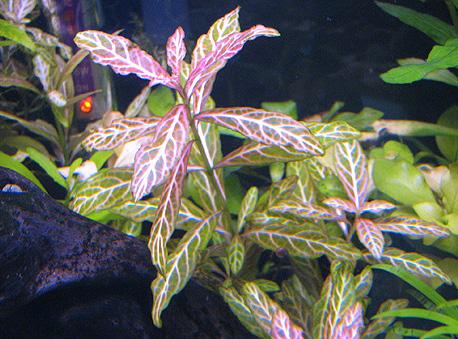
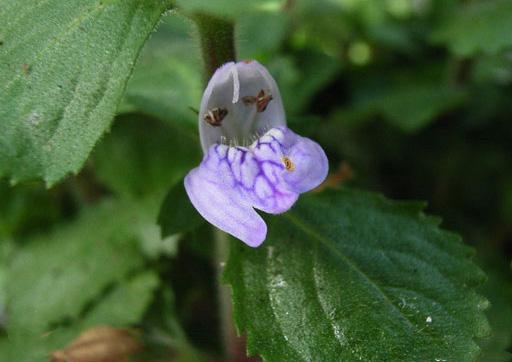
This species is slightly smaller than the other Hygrophila species and has blunt-tipped leaves which distinguish it from the other
of a coarse feather, deeply indented, while the emergent leaves are much smaller and a broad oval shape with small teeth around the edge. Like H. corymbosa, the emergent stems smell. It is native to the Indian
commonly-cultivated species in New Zealand. There is a red-leaved form known as “Sunset”.
It has naturalised in the USA and Australia and is considered an invasive weed in those countries. It prefers flowing water but can also grow in slow-moving water. It forms floating mats which shade out submerged plants and limit access to the water.
Although the climates where it is a problem are slightly warmer than New Zealand, it can survive cooler temperatures and has the potential to naturalise here. However, aquarium plants don’t become a problem unless they are released into the wild, so if you are growing this plant, remember not to tip it out near any waterway.
Melanie Newfield
Aquarium World ∙ 35
Hygrophila difformis submerse growth
Photo: Alan Minnery
Hygrophila polysperma 'Sunset'
Photo: Diane Wilkie
Hygrophila difformis emerse growth and flower
Photo: Alan Minnery
SHOP TOUR
KiwiPetz
Fraser Cove Shopping Centre
Shop T30, 237 Fraser Street
Tauranga
kiwipetz@xtra.co.nz, Sales@kiwipetz.co.nz
www.kiwipetz.co.nz
07 578 8623
Hours: Monday - Saturday 9am – 5pm Sunday 10am - 4:30pm
Facilities: 4 coldwater tanks
28 freshwater tropical tanks
7 small Betta tanks
4 tropical plant tanks
1 display tank
KiwiPetz is a spacious, well stocked, familyowned store in the Fraser Cove shopping Centre. It is easy to find, offers ample parking, and staff are very helpful, knowledgeable, and friendly. The shop offers an impressive selection of pet supplies and a dog grooming service.

The aquatic area comprises about 40 clean, wellmaintained tanks, mainly devoted to tropical freshwater species including a good range of small community species (barbs, tetras, and livebearers) several African cichlids, and several more unusual species. There were four coldwater tanks with a good selection of goldfish and an axolotl, four tanks with a variety of tropical aquatic plants, and seven small betta tanks.

36 ∙ Aquarium World


I was impressed by the information sheets for goldfish and an AquaOne testing station. Beside the counter was a good-sized display tank with tetras, large angels, pearl gouramis, and a gold spot pleco.

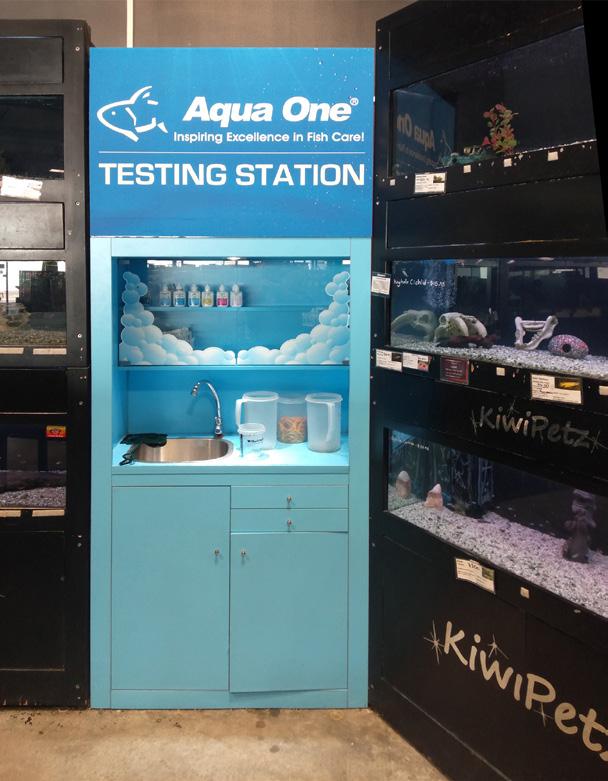
KiwiPetz has an impressive selection of dry goods and consumables including aquariums from 14 to 165 litres, filters, pumps, heaters, food, and medications from leading brands that are likely to cover the needs of most aquarists. They also stock frozen food and reptile supplies.
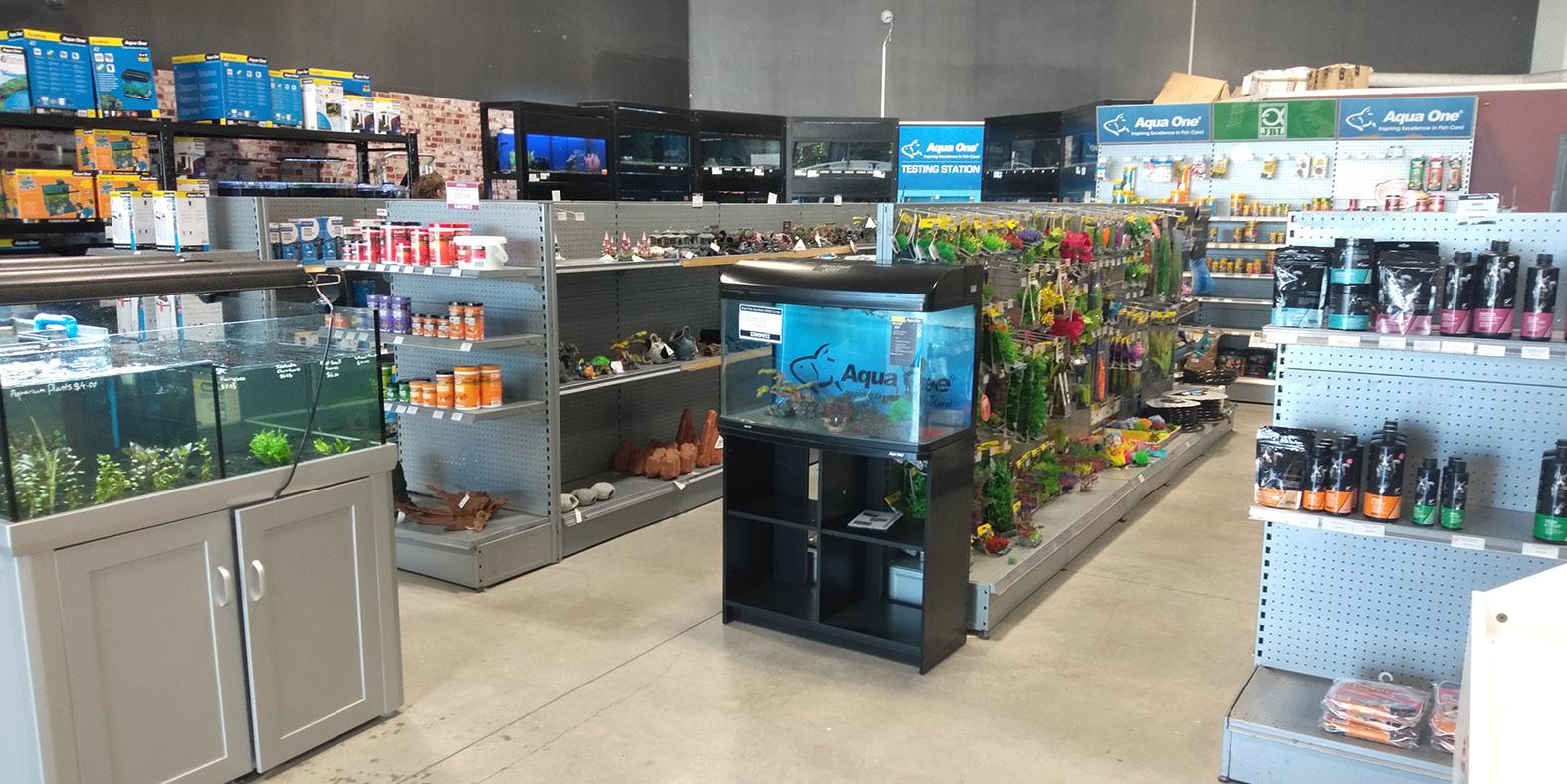

They also offer a 10% discount instore to all FNZAS members upon showing their membership card that can be used on aquarium products but excludes: items already on sale, aquariums, cabinets and canister filters.


If you find yourself in Tauranga, KiwiPetz is well worth a visit.
Darren Stevens
Interesting species
Gold panchax $14
Spotted headstander $22.95
Spotted silver dollars $34.95
Marble peacock $25.95
Cherry red hap $29.95
Orange cockatoo cichlid $55


Red frontosa $61.95
Rank Tropical fish ✭ ✭ ✭ ✭
Catfish ✭ ✭
Cichlids ✭ ✭ ✭
Oddballs ✭ ✭ ✭
Coldwater fish ✭ ✭ ✭
Marine fish N/A
Marine inverts N/A
Marine corals N/A
Display tanks ✭ ✭ ✭
Pond plants N/A
Tropical plants ✭ ✭ ✭
Dry goods ✭ ✭ ✭ ✭
Pond supplies ✭ ✭ ✭ ✭
Aquarium World ∙ 39
Electric blue acara
Photo: Darren Stevens
Marble peacock
Photo: Darren Stevens
INTERESTING IMPORTS
The importers continue to offer a great selection of tropical fish, including some striking ornamental varieties.
For beginners, it’s hard to go past the everpopular guppies and there are plenty of colourful males to choose from including blue cobra, German yellow, golden koi, midnight blue, red lyretail, sunset, and pink tuxedo.
If you like albino fish, why not try an albino neon, glowlight, or Buenos Aires tetra, or an albino cory. Paradise fish and kribensis also come in white, as do cobalt and Malawi cichlids. And for those with extra large tanks, albino tinfoil barbs, red tiger oscars, and Senegal bichirs are all available.


If longfinned fish are more your thing then why not try a cherry barb, black widow
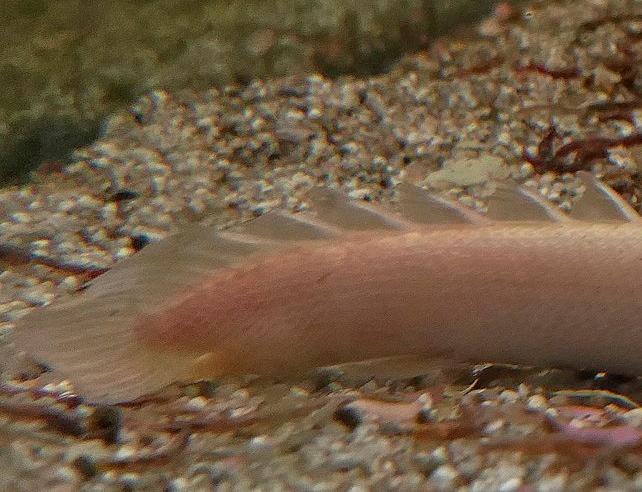 albino cherry barb
albino cherry barb
40 ∙
World
Photo: Robert Beke
Aquarium
Discus
Photo: Virgine Beltran
tetra, serpae tetra, or a longfinned albino bristlenose.


If the controversial hybrid parrot cichlid is more to your liking, they are available in blood red, blue tiger, red, and yellow.
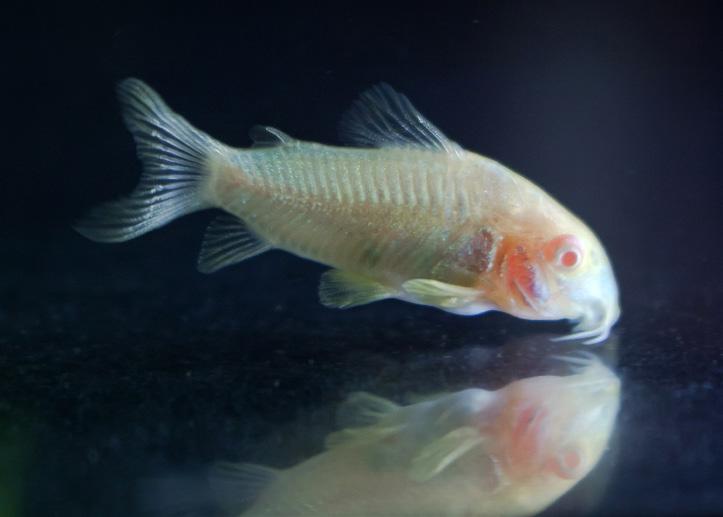
And finally, if you are after a stunning feature fish or two, there is a great range of discus available including: blue diamond,
brilliant blue, cobalt, leopard snakeskin, orange checkerboard, orange map, rainbow pigeon, red melon, red turquoise, and red rising sun.
The editorial team
albino senegal bichir - Polypterus senegalus
Photo: 5snake5i
albino cory - Corydoras aneus
Photo: Gabriel Resende Veiga
Longfin albino bristlenose
Photo: Robert Beke
IMAGE SOURCES
Pg Source
10 Chocolate Gourami Sphaerichthys osphromenoides Photo: Tsunamicarlos, https://commons.wikimedia.org/wiki/File:Sphaerichthys_ osphromenoides.jpg
26 Long finned serpae tetra Hyphessobrycon eques, Photo: Faucon, https://commons.wikimedia.org/wiki/File:Serpae_tetra.jpg
34 Hygrophila ringens, Photo: ©Jack Warden, some rights reserved (CC BY-NC), https://inaturalist.nz/photos/199835179
40 Albino senegal bichir Polypterus senegalus Photo: 5snake5, https://commons.wikimedia.org/wiki/File:Polypterus_senegalus_-_ Senegal-Fl%C3%B6sselhecht_-_Albino.jpg
41 Albino cory Corydoras aneus Photo: Gabriel Resende Veiga, https://commons.wikimedia.org/wiki/File:Corydoras_aeneus_02.jpg
42 ∙ Aquarium World
The Federation of New Zealand Aquatic Societies is a group of aquarists dedicated to supporting and promoting fishkeeping as a hobby, both in our local communities and globally with regard to conservation of aquatic species and their environments. The organisation is dedicated to the improvement of the aquarium and fishkeeping hobby and it has a 60 year history of representing aquarium societies in New Zealand.
Current affiliated aquarium clubs in New Zealand:
DUNEDIN AQUARIUM AND POND SOCIETY
CONTACT: Nic Smith dapsdunedin@gmail.com
HAWKE’S BAY AQUARIUM SOCIETY INCORPORATED
Contact: Chris Drake secretary@hbas.org.nz
FISH & REPTILE KEEPERS HAWKE’S BAY
Contact: Julie Wells farknz2023@gmail.com
MARLBOROUGH AQUARIUM CLUB
Contact: Caryl Simpson caryl@simtronics.co.nz
UPPER HUTT AQUARIUM SOCIETY
Contact: Maxine Lynch uhaquariumsociety@gmail.com
WAIKATO AQUARIUM SOCIETY
Contact: Paul Willard waikatoaquariumsociety@gmail.com
Online Clubs
NEW ZEALAND REEFKEEPERS
Contact via: https://www.facebook.com/groups/nzreefkeepers/
NEW ZEALAND REPTILE AND AMPHIBIAN SOCIETY
Contact via: https://www.facebook.com/groups/NZRAS/
Aquarium World ∙ 43
AFFILIATED CLUBS
FNZAS DISCOUNT
The following businesses offer discounts to our members, remember to ask politely, this is a privilege not a right. You must show your current FNZAS Membersip card at the time of purchase.
AUCKLAND
Hollywood Fish Farm - 10% discount on selected non-sale items
36 Frost Rd. Mt. Roskill Ph 09 620 5249
10/2 Tawa Drive, Albany Ph 09 415 4157
www.hollywoodfishfarm.co.nz
The Bird Barn - 10% discount on fish and accessories
158 Lincoln Rd. Henderson. Ph 09 838 8748.
New Pupuke Aquarium Centre - 10% Discount
1 Lydia Ave, Birkenhead Ph 09 480 6846
GISBORNE
Eastland Aquariums - 10% discount as well as great in-store specials.
132 Grey St, Gisborne Ph/Fax 06 868 6760
HAMILTON
Hollywood Fish Farm - 10% discount on selected non-sale items
90 Greenwood Street, Frankton, Hamilton Ph: 07 212 5570
www.hollywoodfishfarm.co.nz
email: hamilton@hollywoodfishfarm.co.nz
Pure Aquatics - 10% discount on everything.
966 Heaphy Tce. Hamilton. Ph: 07 855 2176
HAWERA
Wholesale & Industrial Supplies - trade price, equating between 15 - 40% off retail prices
49 Glover Rd, Hawera Ph 06 278 7525
MORRINSVILLE
Demitry Pet Supplies - 10% Discount
142 Whitaker Street, Te Aroha. Ph 07 8897789
www.demitry.co.nz
email: demitryfish@gmail.com
44 ∙ Aquarium World
NELSON
The Fishroom
www.thefishroom.co.nz
Email: getfish@thefishroom.co.nz
ROTORUA
Wonderworld Aquarium and Pet Centre - 10% discount
82 - 84 Clayton Road, Rotorua Ph: 07 348 0328
Email: info@wonderworldpetcentre.co.nz
TAURANGA
KiwiPetz - 10% discount
Shop T30, Fraser Cove Shopping Centre, Tauranga Ph 07 578 8623
email kiwipetz@xtra.co.nz
Carine Garden Centre & Water World - 10% discount on fish, fish related products & aquatic plants
Cnr SH2 & Te Karaka Drive, Te Puna Ph. 07 552 4949
www.carine.co.nz
WELLINGTON (and Greater Wellington area)
The Pet Centre - 10% discount on all fish and aquatic products
Lower Hutt - 28 Rutherford Street, Lower Hutt 5010, 04 569 8861
Upper Hutt - 82 Queen Street, Upper Hutt 5018, 04 9745473
Lyall Bay - 117 Tirangi Road, Rongotai 6022, 04 282 1242
Online @ www.thepetcentre.co.nz
Free shipping with orders over $30 + fish club discount still applies
Aquarium World ∙ 45
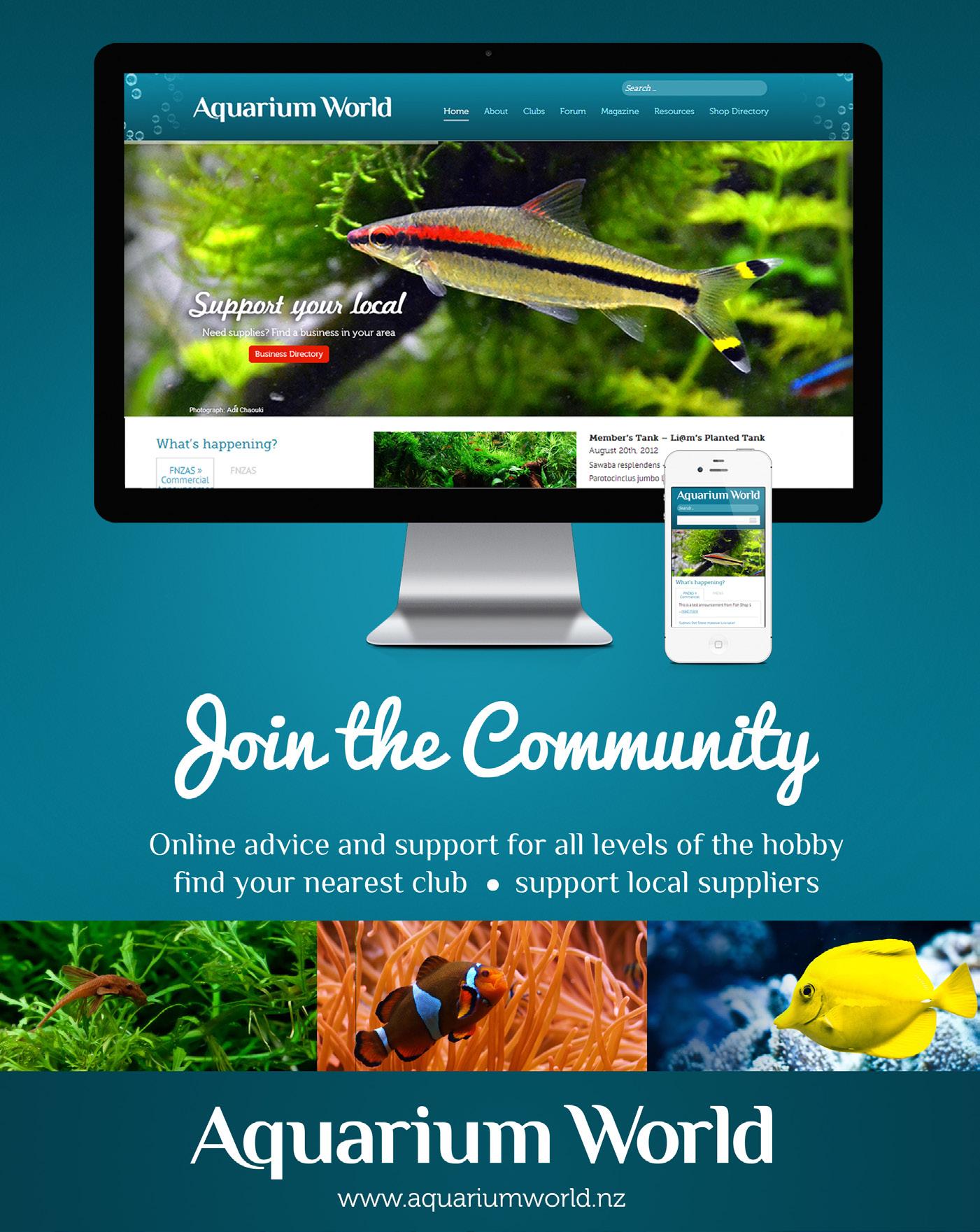







































 Photo David Cooper
Photo David Cooper
 by Aaron Gabb
by Aaron Gabb



 Aaron Gabb
Aaron Gabb










 by Mark Paterson
by Mark Paterson
























 albino cherry barb
albino cherry barb



